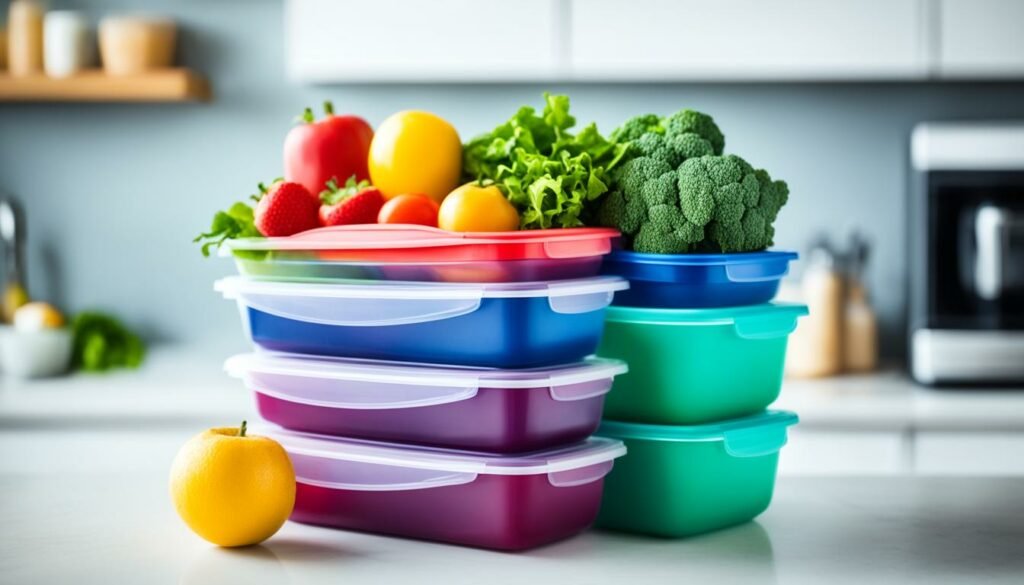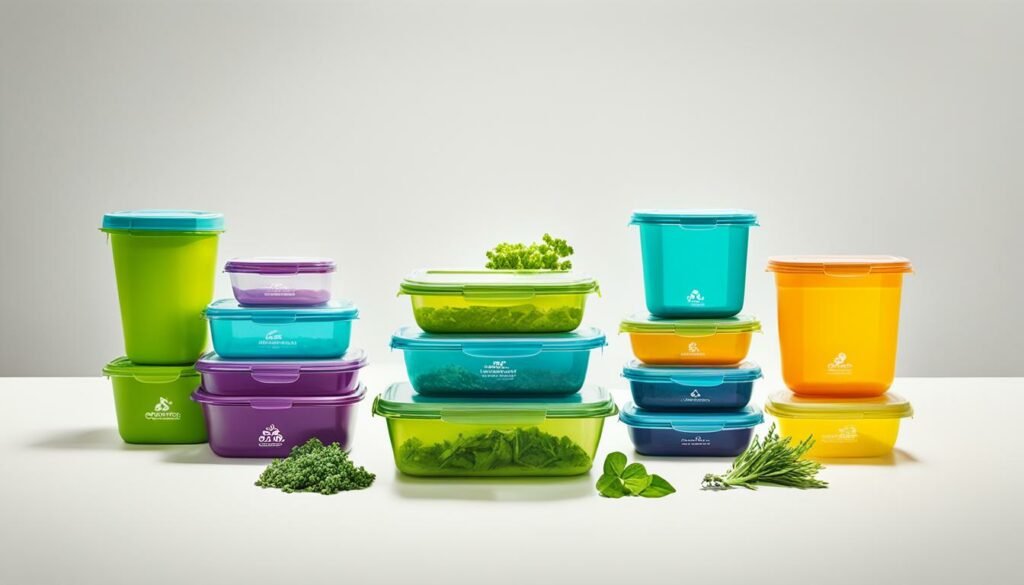I've been on a quest to diminish my carbon footprint and minimize plastic waste. Exploring sustainable food storage options led me to consider vacuum packaging and Tupperware. Both claim to preserve food effectively, but which is better for the environment?
Food preservation has evolved significantly, from ancient cellars to modern technology. Today, our choices affect not just our kitchens but also the planet. This article will examine the environmental impact of vacuum packaging and Tupperware. We'll look at energy consumption, recyclability, and long-term environmental effects.
Let's delve into the advantages and disadvantages of these storage solutions. By understanding their pros and cons, we can make better choices for our meals and the planet. Join me in exploring how to create a greener kitchen and reduce our environmental footprint.
Understanding Food Storage Methods: Vacuum Packaging and Tupperware
Food preservation is essential in our daily lives. I've looked into various methods to keep my meals fresh. Two methods, vacuum packaging and Tupperware, stand out for their effectiveness.
What is Vacuum Packaging?
Vacuum packaging is a contemporary method for storing food. It involves removing air from containers or bags before sealing. This creates a vacuum that significantly extends the shelf life of food. It's particularly useful for preserving meats, cheeses, and vegetables.
The Evolution of Tupperware
Tupperware has been a staple in many homes for decades. These containers have evolved from basic storage to a wide variety of products. I recall my grandmother's colorful Tupperware collection. Now, I use modern designs that are safe for the microwave and dishwasher.
Key Differences in Storage Techniques
When comparing vacuum packaging and Tupperware, several differences emerge:
- Sealing Method: Vacuum packaging removes air, while Tupperware relies on airtight lids
- Space Efficiency: Vacuum-sealed bags take up less space in my fridge
- Food Types: Tupperware is ideal for leftovers, while vacuum packaging is better for raw ingredients
- Shelf Life: Vacuum packaging generally extends food freshness longer
- Convenience: Tupperware is easier for daily use and reheating
Both methods have their role in my kitchen, offering unique benefits for different food preservation needs.
Environmental Impact of Vacuum Packaging
Vacuum packaging has become a common method for food storage, yet its environmental implications are concerning. I've delved into this topic to shed light on its effects on our planet.
Plastic Usage and Waste Generation
This method heavily depends on single-use plastic bags. Although these bags help extend the shelf life of food, they exacerbate plastic waste issues. For every pound of food preserved, approximately 0.5 ounces of plastic are utilized.
Energy Consumption in Production and Use
The production and operation of vacuum sealers affect energy efficiency. A standard vacuum sealer consumes about 110-120 watts per hour. Over a year, this equates to 20-30 kWh, akin to powering a small LED TV for a month.
Recyclability and End-of-Life Considerations
Recyclability of vacuum-sealed bags is restricted. Most end up in landfills or incinerators. However, some companies are pioneering eco-friendly alternatives, though their adoption is gradual.
| Aspect | Impact | Mitigation Strategies |
|---|---|---|
| Plastic Waste | High | Use thicker, reusable bags |
| Energy Use | Moderate | Opt for energy-efficient models |
| Recyclability | Low | Support recycling programs |
Despite its benefits, vacuum packaging's environmental footprint is substantial. Striking a balance between food preservation, plastic waste reduction, and energy efficiency poses a challenge for both consumers and manufacturers.
Eco-friendliness of Tupperware

I've been a devoted user of Tupperware for years, consistently impressed by its longevity. These containers are ideal for sustainable food storage, aiding in my effort to diminish single-use plastic consumption. Their enduring nature allows me to reuse them extensively, thereby significantly reducing waste.
The initial production of Tupperware involves plastic manufacturing, which might seem counterintuitive for eco-friendliness. However, the long-term advantages often compensate for this. The true environmental impact of these containers hinges on their lifespan and proper disposal at the end of their utility.
Recently, many Tupperware items have been crafted from recycled materials, marking a significant sustainability milestone. This transition to recycled plastics boosts their eco-friendly credentials. Among plastic alternatives, Tupperware is unparalleled in terms of durability and reusability.
- Durable and long-lasting
- Reduces need for single-use plastics
- Some products made from recycled materials
- Reusable for many years
The true environmental benefits of Tupperware extend beyond the product itself. It's about the choices we make in using it. Opting for these reusable containers over disposable ones has a positive environmental impact. Each time I use a Tupperware container for lunch, I'm supporting sustainable food storage and contributing to a healthier planet.
Benefits and Drawbacks of Each Method
When examining food storage, both vacuum packaging and Tupperware stand out with their distinct benefits. Each method provides unique advantages for preserving food and enhancing storage convenience. Let's delve into the pros and cons of these popular solutions.
Food Preservation Efficiency
Vacuum packaging excels in long-term food preservation by eliminating air, thus preventing freezer burn and prolonging shelf life. Conversely, Tupperware is adept at maintaining food freshness for shorter durations, ideal for everyday use.
Reusability and Longevity
Tupperware is renowned for its reusability, offering durability that can last for years with proper maintenance. In contrast, while vacuum bags can be reused, their lifespan is shorter and their versatility is limited.

Space Efficiency and Storage Convenience
Vacuum-sealed bags are ideal for saving space, especially in compact freezers. Tupperware also offers a variety of sizes, accommodating diverse storage requirements. However, it may occupy more space overall.
| Feature | Vacuum Packaging | Tupperware |
|---|---|---|
| Food Preservation | Excellent for long-term | Good for short-term |
| Reusability | Limited | High |
| Space Efficiency | Very high | Moderate |
| Initial Cost | Higher (sealer required) | Lower |
| Versatility | Limited food types | Wide range of foods |
Deciding between vacuum packaging and Tupperware hinges on your specific requirements. For extended storage and freezer space optimization, vacuum sealing is the superior choice. For daily use and versatility, Tupperware remains a preferred option. Consider your food preservation and storage needs to make an informed decision.
Conclusion: Making an Informed Choice for Sustainable Food Storage
When exploring sustainable food storage, both vacuum packaging and Tupperware stand out. The choice between them hinges on individual needs and environmental concerns.
Vacuum packaging excels in preserving food, extending its shelf life. This approach can notably cut down on food waste, a key aspect of reducing our ecological footprint. However, the use of single-use plastics in vacuum sealing raises sustainability doubts.
Tupperware, being reusable, presents a sustainable alternative for daily storage. Though it may not outlast vacuum sealing, its longevity and adaptability are ideal for those aiming to decrease plastic waste.
My personal approach combines both methods to enhance food storage sustainability. For extended storage of bulk items or meal prep, vacuum sealing is crucial. For daily leftovers and brief storage, Tupperware is preferred.
When selecting a method, consider these elements:
- Frequency of use
- Types of food stored
- Personal commitment to reducing plastic waste
- Available storage space
Assessing these factors allows for a well-informed decision that matches your lifestyle and environmental objectives. Every step towards sustainable food storage helps pave the way for a greener future.
Future Trends in Eco-Friendly Food Storage
The future of food storage is thrilling, with a strong emphasis on innovative solutions that prioritize the environment. We're witnessing a surge in the adoption of biodegradable materials within vacuum seal bags. These advancements ensure that food remains fresh while minimizing ecological impact.
Reusable containers are undergoing significant enhancements, featuring improved seals to extend the shelf life of food. Some models now incorporate technology that alerts us when items are nearing spoilage. This innovation not only reduces waste but also benefits both our wallets and the planet.
Currently, companies are pioneering the fusion of sustainable packaging with reusable designs. This blend offers the freshness of vacuum sealing alongside the eco-friendliness of reusable containers. As consumer demand for green products grows, we can anticipate a plethora of groundbreaking innovations hitting the market soon.
FAQ
What is the main difference between vacuum packaging and Tupperware?
Vacuum packaging removes air from containers or bags before sealing, creating an airtight environment. This method extends the shelf life of food. Tupperware, in contrast, refers to reusable plastic containers. They don't necessarily create an airtight seal but offer convenience and reusability.
Which method is more eco-friendly: vacuum packaging or Tupperware?
Tupperware and similar reusable containers are generally more eco-friendly. They reduce plastic waste compared to vacuum packaging. Vacuum packaging often uses single-use plastic bags, contributing to plastic waste. Tupperware can be used repeatedly, thus reducing overall plastic waste.
How does vacuum packaging impact the environment?
Vacuum packaging contributes to plastic waste due to the use of single-use plastic bags. It also requires energy for production and the use of vacuum sealing machines. Moreover, the recyclability of vacuum-sealed bags is limited, posing end-of-life environmental concerns.
What factors make Tupperware a more sustainable option?
Tupperware is durable and long-lasting, reducing overall plastic waste. Some Tupperware products are made from recycled materials, enhancing their sustainability. However, the initial production of Tupperware involves plastic manufacturing.
Which method is better for food preservation: vacuum packaging or Tupperware?
Vacuum packaging generally excels in food preservation, especially for long-term storage and freezer use. It prevents freezer burn and extends shelf life significantly. Tupperware offers better reusability but may not preserve food as long as vacuum packaging.
How can I balance food preservation and environmental impact in my food storage choices?
Consider factors like frequency of use, types of food stored, and personal commitment to reducing plastic waste. A combination of vacuum packaging for long-term storage and Tupperware for daily use can help optimize food storage while minimizing environmental impact.
Source Links
- https://medium.com/@foodmagazineofficial/vacuum-packaging-vs-traditional-food-storage-pros-and-cons-e7fd5b1134a8
- https://ankomn.com/blogs/news/vacuum-sealers-vs-vacuum-sealed-containers-which-is-better-for-your-food-storage?srsltid=AfmBOoo59XLIEDghc6cJOaWf4FBnR-lBDyuN_zc0jghUdWvPOsoHSgoX
- https://www.reddit.com/r/MealPrepSunday/comments/15mkmfe/does_anyone_vacuum_seal_their_food_or_meals/
